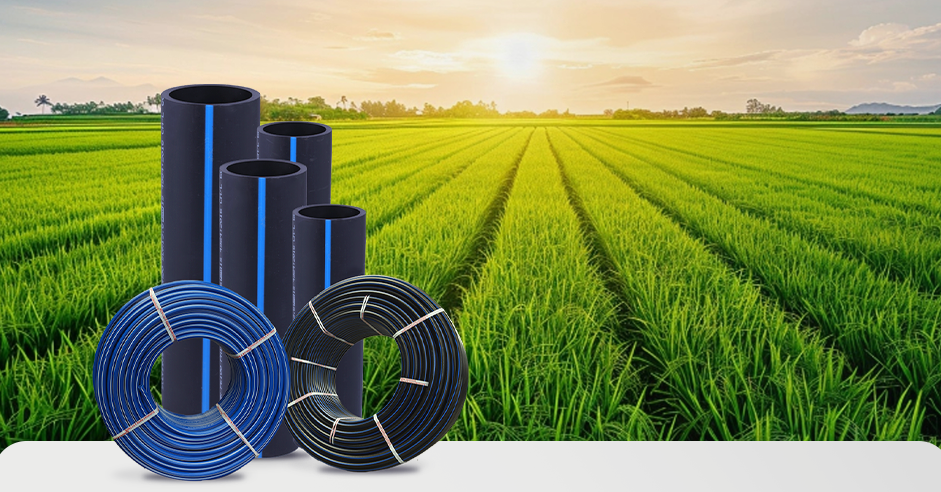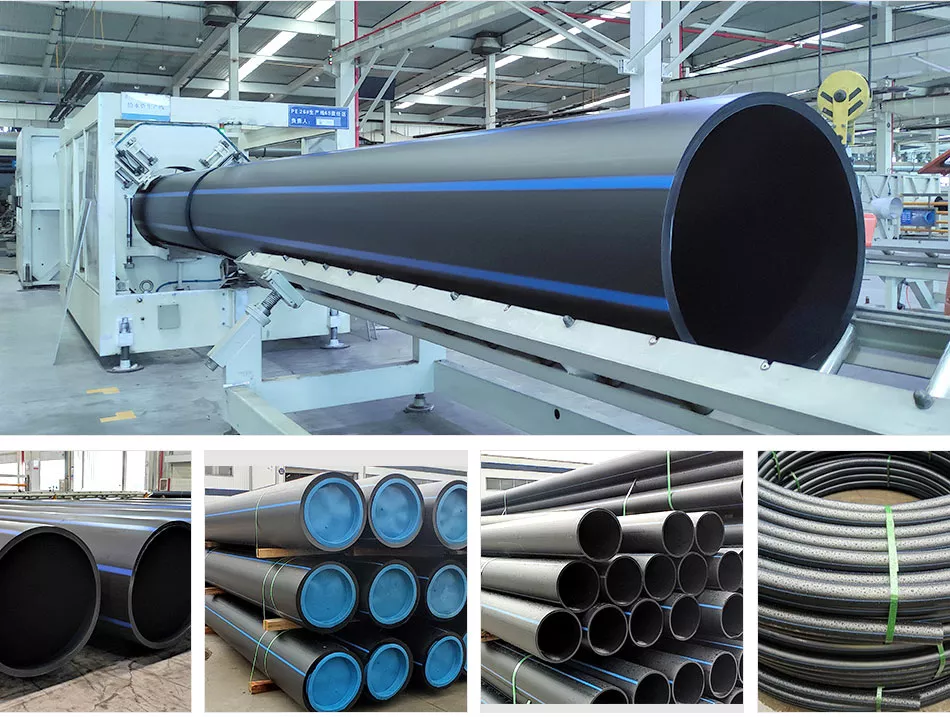Why Partnering with Pipe Supplier American Plastics Midland Ensures Quality Assurance
Wiki Article
The Crucial Steps for Successful Setup of HDPE Pipeline in Your Next Project
Successful setup of HDPE pipeline requires cautious planning and implementation. Key steps include assessing job demands, preparing the site, and picking proper joining techniques. Each phase plays a critical duty in making certain the honesty and efficiency of the pipeline. Comprehending these vital actions can greatly influence the general success of the project - Texas hdpe pipe manufacturer. However, the subtleties of each step may hold the trick to overcoming usual difficulties dealt with throughout installmentRecognizing the Perks of HDPE Pipe
High-density polyethylene (HDPE) pipeline offers many advantages that make it a favored choice for different applications. Its high resistance to corrosion and chemicals warranties toughness sought after atmospheres, greatly expanding the life expectancy of installations. In addition, HDPE's versatility enables easier installation, particularly in tough terrains, as it can bend without breaking. The lightweight nature of HDPE pipe simplifies transport and handling, decreasing labor expenses throughout installment.Additionally, HDPE pipeline is known for its low rubbing coefficient, which boosts liquid flow and minimizes power usage. Its seamless building and construction reduces the risk of leakages, adding to far better resource management and environmental protection. In enhancement, HDPE is recyclable, aligning with lasting methods and minimizing ecological impact. In general, the combination of strength, versatility, and eco-friendliness makes HDPE pipe a remarkable selection for a vast array of tasks, from water circulation to commercial applications.
Planning Your HDPE Pipe Setup
When intending an installment of HDPE pipeline, cautious factor to consider of a number of key factors is important to secure an effective task. First, job managers have to examine the particular requirements of the pipeline, consisting of the planned usage, flow rates, and environmental conditions. Recognizing these specifications will assist the choice of suitable pipeline dimensions and product quality.Next, timelines should be developed, factoring in purchase timetables and any kind of possible delays. Sychronisation with neighborhood authorities for authorizations and regulatory conformity is additionally necessary. In addition, a comprehensive spending plan needs to be prepared, incorporating all prices connected with materials, labor, and machinery.
Last but not least, it is necessary to involve a certified team experienced in HDPE pipe installation. Their experience will certainly help mitigate risks, assurance adherence to industry criteria, and ultimately add to the job's success. Extensive planning lays the foundation for a smooth installation procedure and lasting efficiency of the HDPE piping system.
Preparing the Site for Installation
Appropriate website prep work is important for the effective installation of HDPE pipe. Before installment begins, the site has to be extensively analyzed to guarantee it meets all essential requirements. This consists of evaluating the ground for existing frameworks, utilities, and potential threats that could impede the installation procedure.

Proper elevation and positioning must be established to maintain a consistent gradient for drainage objectives. Appropriate water drainage around the installation website is also imperative to prevent water buildup, which can lead to complications down the line.
Methods for Joining HDPE Pipelines
Accomplishing a trustworthy connection between HDPE pipes is important for ensuring the stability and durability of the installation. Various methods exist for joining these pipes, each suited for different task requirements. Blend welding is among one of the most common techniques, using heat to bond the pipeline finishes together, producing a smooth and durable link. This technique can be more categorized into outlet combination and butt blend, relying on the pipe setups.Mechanical installations are an additional choice, using clamps and threaded connectors to join sections of HDPE pipeline. While generally faster to set up, they might need additional upkeep over time. Electrofusion is a customized technique that involves utilizing electric current to warm and fuse the pipelines with specially created installations, ensuring a solid bond. Selecting the proper joining strategy is important, as it directly affects the overall performance and dependability of the HDPE piping system in the desired application.
Checking and Evaluation of Installed Water Lines
The testing and examination of installed HDPE pipelines are vital to guaranteeing their performance and long life. This process incorporates aesthetic examination strategies, stress screening approaches, and leakage detection treatments to recognize prospective issues. By employing these methods, specialists can validate the stability of the installation before it is put right into use.Visual Examination Techniques
Utilizing reliable visual evaluation methods is crucial for ensuring the integrity of installed HDPE pipelines. Assessors need to methodically analyze all visible sections of the pipeline to determine any kind of indications of damages, imbalance, or improper setup. Trick indicators to evaluate include joint stability, surface irregularities, and links. Examiners might utilize devices such as amplifying glasses or cams to enhance visibility and information. It is necessary to check for indicators of ecological stress, such as bending or too much bending, which can endanger efficiency. Regular documentation of searchings for enables tracking modifications with time and aids guide see page needed repair work. By adhering to recognized visual examination protocols, project groups can significantly reduce the risk of future failings and ensure long-term integrity of the piping system.Stress Testing Methods
Aesthetic inspection functions as an initial measure, yet it is not enough on its own to ensure the performance of set up HDPE pipes. Pressure screening techniques are necessary for guaranteeing the honesty of these systems. Normally, hydrostatic screening is employed, where the pipelines are loaded with water and subjected to stress degrees above the designated operating stress. This approach aids recognize weaknesses or prospective leaks. Pneumatically-driven testing can also be made use of, although it carries higher threats because of the compressibility of air. No matter of the technique picked, adhering to sector standards and safety and security methods is important. After carrying out stress examinations, comprehensive documents is necessary to validate the results and confirm that the installment satisfies all operational needs prior to continuing to the following stage of the task.
Leak Discovery Procedures
Just how can one ensure that set up HDPE pipelines are totally free from leaks? Effective leakage discovery treatments are important to secure the stability of the system. Visual evaluations must be done, looking for indications of water buildup or soil erosion around pipeline joints. Following this, pressure testing can confirm the system's toughness. A typical method is the hydrostatic examination, where water is presented under pressure, monitoring for declines that show possible leaks. Additionally, progressed innovations, such as acoustic sensing units or infrared thermography, can identify leakages that may not show up. Routine tracking and upkeep additional add to the longevity of HDPE pipelines, ensuring they continue to be leak-free throughout their functional life-span. Correct documents of these procedures is important for compliance and future referral.Maintenance Tips for Long-Term Efficiency
To assure the long life of HDPE pipes, establishing a regular examination routine is crucial. This positive approach enables the very early discovery of possible problems, reducing costly fixings. Additionally, implementing proper cleaning techniques will help preserve peak efficiency and stop accumulation that can impact functionality.Routine Assessment Set Up
Although HDPE pipelines are known for their durability and resistance to corrosion, developing a routine examination schedule is essential for guaranteeing their lasting performance. Routine inspections aid recognize potential issues such as leaks, joint integrity, and environmental impacts that might affect the pipe's performance. It is suggested that examinations occur a minimum of biannually, or much more often in atmospheres with severe conditions. custom hdpe pipe manufacturing Midland TX. During these assessments, aesthetic checks need to be conducted to spot indicators of wear or damages. Additionally, utilizing modern technology such as ultrasonic screening can provide further understandings right into the pipeline's problem. By carrying out a structured evaluation schedule, task managers can proactively deal with problems, thereby prolonging the life expectancy of HDPE pipes and keeping system performanceProper Cleaning Techniques
Appropriate cleaning methods play an important function in maintaining the lasting efficiency of HDPE pipes. Routine cleansing avoids the buildup of debris, debris, and biofilm, which can cause clogs and reduced flow performance. Operators ought to employ approaches such as high-pressure water jetting or foam cleansing to successfully remove impurities without damaging the pipe surface. It is essential to prevent using extreme chemicals that might break down HDPE material. Furthermore, scheduled upkeep checks ought to consist of aesthetic evaluations for any kind of indicators of wear or damages. Appropriately trained workers need my sources to accomplish these cleansing procedures, making certain conformity with safety and security and environmental laws. By applying these techniques, the lifespan of sewage line cleaning services HDPE pipes can be significantly prolonged, making certain ideal performance throughout their functional life.Regularly Asked Concerns
What Are the Environmental Effects of HDPE Pipeline Manufacturing?
The environmental influences of HDPE pipe manufacturing consist of greenhouse gas emissions, energy intake throughout manufacturing, potential plastic air pollution, and obstacles in recycling. HDPE's longevity and resistance to rust can reduce some environmental worries.Exactly How Does HDPE Pipeline Contrast to Other Products?

What Equipment Are Required for HDPE Pipe Setup?
Vital tools for HDPE pipe installation include a blend machine, pipe cutters, shovels, determining tape, and safety gear. Proper tools assurances effective, safe handling and setup, adding to the project's general success and honesty.Are There Any Kind Of Certain Laws for HDPE Pipe Installment?
Details laws for HDPE pipe setup vary by area, frequently controlled by neighborhood, state, or federal codes. Conformity with these regulations guarantees safety and security, environmental protection, and performance, making adherence necessary for effective task end results.Can HDPE Pipeline Be Recycled After Use?
Yes, HDPE pipes can be reused after usage. Their thermoplastic nature permits reprocessing, making them appropriate for reusing into new items. This sustainability aspect adds to environmental preservation and promotes round economy practices in building.Report this wiki page